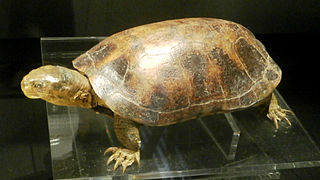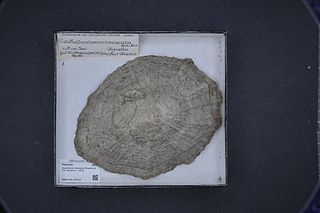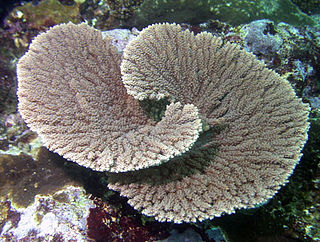
Isoetes, commonly known as the quillworts, is a genus of lycopod. It is the only living genus in the family Isoetaceae and order Isoetales. There are currently 192 recognized species, with a cosmopolitan distribution mostly in aquatic habitats but with the individual species often scarce to rare. Some botanists split the genus, separating two South American species into the genus Stylites, although molecular data place these species among other species of Isoetes, so that Stylites does not warrant taxonomic recognition. Species virtually identical to modern quillworts have existed since the Jurassic epoch, though the timing of the origin of modern Isoetes is subject to considerable uncertainty.
Freshwater ecosystems are a subset of Earth's aquatic ecosystems. They include lakes, ponds, rivers, streams, springs, bogs, and wetlands. They can be contrasted with marine ecosystems, which have a larger salt content. Freshwater habitats can be classified by different factors, including temperature, light penetration, nutrients, and vegetation. There are three basic types of freshwater ecosystems: Lentic, lotic and wetlands. Freshwater ecosystems contain 41% of the world's known fish species.

Isoetales, sometimes also written Isoëtales, is an order of plants in the class Lycopodiopsida.

The Murray crayfish, Euastacus armatus, is a species of freshwater crayfish endemic to Australia that belongs to the family Parastacidae. The Murray crayfish has the largest geographic range of any of the Euastacus crayfish in Australia, being found in the Murray and Murrumbidgee Rivers as well as many of their tributaries. Murray crayfish are also known as "Murray River crayfish", "Murray crays", "freshwater crays", "spiny freshwater crays", "spinies" and in the Wagga Wagga region of southern New South Wales they are simply known as "lobsters".

The Tethys Research Institute is a non-profit research organisation founded in 1986 to support marine conservation through science and public awareness and by participating in the international conservation process. Tethys' activities are mainly carried out in the Mediterranean Sea, although research programmes have been conducted also in the Black Sea, the North Atlantic Ocean, the Caribbean, the Red Sea and Antarctica. The results of these activities have been presented in scientific publications as well as in meetings, workshops and conferences.

The devil fish or giant devil ray is a species of ray in the family Mobulidae. It is currently listed as endangered, mostly due to bycatch mortality in unrelated fisheries.

Unio crassus, the thick shelled river mussel, is a species of freshwater mussel, an aquatic bivalve mollusk in the family Unionidae, the river mussels.

The Mary River turtle is an endangered species of short-necked turtle in the family Chelidae. The species is endemic to the Mary River in south-east Queensland, Australia. Although this turtle was known to inhabit the Mary River for nearly 30 years, it was not until 1994 that it was recognised as a new species. There has been a dramatic decrease in its population due to low reproduction rates and an increase of depredation on nests.

Maerl is a collective name for non-geniculate coralline red algae with a certain growth habit. Maerl grows at a rate of c. 1 mm per year. It accumulates as unattached particles and forms extensive beds in suitable sublittoral sites. The term maerl originally refers to the branched growth form of Lemoine (1910) and rhodolith is a sedimentological or genetic term for both the nodular and branched growth forms.

Rhodoliths are colorful, unattached calcareous nodules, composed of crustose, benthic marine red algae that resemble coral. Rhodolith beds create biogenic habitat for diverse benthic communities. The rhodolithic growth habit has been attained by a number of unrelated coralline red algae, organisms that deposit calcium carbonate within their cell walls to form hard structures or nodules that resemble beds of coral.
The Maluti redfin is a ray-finned fish species in the family Cyprinidae. It is colloquially called the Maluti minnow, but it is not a true minnow.

The yellow pond turtle, is a medium-sized, semiaquatic turtle in the family Geoemydidae. This species has a characteristic broad yellow stripe extending behind the eye and down the neck; the carapace ranges in color from grayish brown to brown, and the plastron is yellow or orange with black blotches along the outer edges. It is native to East Asia, ranging from central Vietnam and Laos, north through the coastal provinces of south and central China, with insular populations known from Taiwan, Hainan and the Ryukyu Islands. Although populations in the southern Ryukyus are thought to be native, populations in the northern and central Ryukyus, as well as central Japan, are believed to have been introduced as a result of imports from Taiwan.

Galaxias fontanus, the Swan galaxias, is a species of fish in the family Galaxiidae. It is endemic to eastern Tasmania, Australia.
Elimia gibbera was a species of freshwater snails with an operculum, aquatic gastropod mollusks in the family Pleuroceridae. This species was endemic to the United States. It is now extinct, the attributed cause is land-use change.

The spiny seahorse, also referred to as the thorny seahorse, is a small marine fish in the family Syngnathidae, native to the Indo-Pacific area. It is classified as a Vulnerable species by the IUCN.

Scutellastra mexicana is a species of true limpet, a marine gastropod mollusk in the family Patellidae. It is the largest known limpet in the world.
John M Baxter is a Scottish marine biologist and was the Principal Adviser - Marine for Scottish Natural Heritage. He is the chief editor (marine) for the international journal Aquatic Conservation: Marine and Freshwater Ecosystems.
The gill plate trade is the buying and selling of stingray gill plates for their use in traditional Chinese medicine. The gill plates are harvested from stingrays that are caught intentionally, or caught as bycatch. The plates are sold whole or in a powder form. A single kilogram of the gill plate can be sold for up to US$350, though the price varies by ray species.

Important Marine Mammal Areas (IMMAs) were formulated by the joint International Union for Conservation of Nature (IUCN) Species Survival Commission / World Commission on Protected Areas, Marine Mammal Protected Areas Task Force (MMPATF)

Acropora clathrata, commonly known as lattice table coral is a species of stony corals belonging to the family Acroporidae. They are a zooxanthellate coral, which are generally found in fringing reefs, sheltered reefs and back reef habitats, between the depths of 5–40 m (16–131 ft). Its size varies according to the depth at which they are found, with members of the species that have larger surface areas typically found at greater depths.















